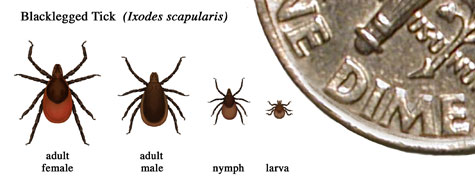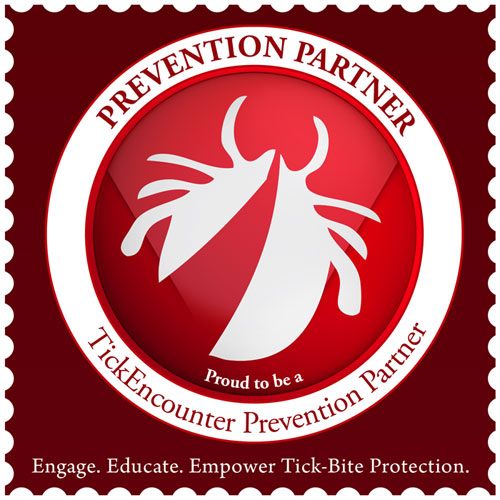Program Goal
To prevent the spread of communicable diseases.
Eligibility
St. Lawrence County residents.
Description
This program includes surveillance, investigation, intervention, reporting and follow-up of reportable communicable diseases to reduce the spread of disease in the St. Lawrence County community.
Current outbreaks reported by NYSDOH.
- Tick-Borne Illness
-

.jpg)
Images of ticks found in and around Northern New York Lyme Disease Lyme disease is an infection caused by the bacteria Borrelia burgdorferi and is spread to humans through the bite of infected blacklegged ticks (or deer ticks). Not all deer ticks are infected with the bacteria. Lyme disease can affect people of any age. A vaccine for Lyme disease is not currently available. Lyme disease is the most prevalent tick-borne disease in New York and has been reportable since 1986.
For more information: CDC Lyme Disease
Anaplasmosis and Ehrlichiosis Anaplasmosis and Ehrlichiosis are two closely related tick-borne bacterial diseases spread by the bite of infected ticks. Anaplasmosis, formerly called human granulocytic ehrlichiosis (HGE), is spread to humans by blacklegged deer ticks infected with the bacterium, Anaplasma phagocytophilia. Ehrlichiosis, or human monocytic ehrlichiosis (HME), is spread to humans by lone star ticks infected with the bacterium, Ehrlichia chaffeensis. In New York State, most cases have been reported on Long Island and in the Hudson Valley, although Anaplasmosis has become much more prevalent in Northern NY, including St. Lawrence County.
For more information: NYSDOH Anaplasmosis and Ehrlichiosis (Tick-borne Bacterial Infections)
Babesiosis Babesiosis is a rare, sometimes severe, disease caused by the bite of a tick infected with Babesia sp., a microscopic (tiny) parasite that infects red blood cells. In New York State, the Babesia species that infects people is Babesia microti, which is spread by the bite of an infected blacklegged (or deer) tick. Babesiosis can affect people of any age.
For information: NYSDOH BabesiosisRocky Mountain Spotted Fever Rocky Mountain spotted fever (RMSF) is a disease caused by the bite of a tick infected with the bacterium Rickettsia rickettsii. In New York, the American dog tick (Dermacentar variablis) is the most common tick that spreads the disease. Fewer than 50 cases are reported annually in New York State. RMSF is a serious illness that can be fatal in the first 8 days of symptoms if not treated correctly, even in previously healthy people. The course of the disease varies greatly. Patients who are treated early may recover quickly on outpatient medication, while those who experience a more severe course may require intravenous antibiotics, prolonged hospitalization or intensive care.
For more information: NYSDHOH Rocky Mountain Spotted Fever (tick-borne typhus fever)
Powasson
Powassan (POW) virus disease is rare, but often serious disease caused by a virus that is spread by the bite of infected American dog ticks. The virus is not transmitted directly from person-to-person. The virus is named after Powassan, Ontario where it was first discovered in 1958. It can cause symptoms ranging from mild flu-like symptoms to life threatening encephalitis (inflammation of the brain). In New York State, there are 1 to 2 cases of POW virus disease per year.
For more information: Powassan Virus (POW) | NYS Department of HealthAdditional resources on ticks and tick-borne illness: Lyme Disease (Tick-Borne borreliosis, Lyme Arthritis) Fact Sheet
Lyme Disease and Other Diseases Carried by Ticks
Repellents: Protection against Mosquitoes, Ticks and Other Arthropods | US EPA
The University of Rhode Island Tick Encounter
- Enteric (Intestinal) Disease
-
Bacteria typically enter the body through the mouth. They are usually acquired through contaminated food and water, by contact with animals or their environments, by contact with the feces of an infected person but can be acquired through other means.
Some of the most commonly seen enteric diseases in St. Lawrence County area include:
Campylobacteriosis
Campylobacteriosis is an illness caused by the Campylobacter bacteria. It causes diarrhea (loose stool/poop) and is the most common cause of bacterial diarrhea in New York State. The majority of cases are seen in the summer months and occur as single cases. Outbreaks (when two or more people become ill from the same source) are uncommon.
For more information: Campylobacteriosis | NYS Department of Health
Cryptosporidiosis
Cryptosporidiosis, commonly known as Crypto, is caused by a tiny parasite called Cryptosporidium and gives an infected person diarrhea (loose stool/poop). The parasite lives in the gut of infected animals and people and spreads to others through drinking contaminated water, swimming or going into contaminated recreational water sources (i.e. pools, waterparks, lakes), eating contaminated food, or contact with infected animals. Cryptosporidium is a leading cause of waterborne disease in the United States.
For more information: Cryptosporidiosis | NYS Department of Health
Giardiasis "Bever Fever"
Giardiasis is a Cryptosporidiosis, commonly known as Crypto, is caused by a tiny parasite called Cryptosporidium and gives an infected person diarrhea (loose stool/poop). The parasite lives in the gut of infected animals and people and spreads to others through drinking contaminated water, swimming or going into contaminated recreational water sources (i.e. pools, waterparks, lakes), eating contaminated food, or contact with infected animals. Cryptosporidium is a leading cause of waterborne disease in the United States.
For more information: Giardiasis (beaver fever) | NYS Department of Health
Salmonellosis
Salmonellosis is an infection with bacteria called Salmonella, which generally affects the intestines (bowels/gut) and occasionally the bloodstream. It is one of the more common causes of diarrheal illness with several thousand cases occurring in New York State each year. Most cases occur in the summer months.
For more information: Salmonellosis | NYS Department of Health
Yersiniosis
Yersiniosis is a bacterial disease that generally affects the intestinal tract (bowels) caused by bacteria. It is a relatively uncommon disease causing an estimated 117,000 illnesses in the United States each year. Most people become infected by eating contaminated pork food products or through contact with a person who has prepared a contaminated food product.
For more information: Yersiniosis | NYS Department of Health
How to prevent the spread of illness:
Hand hygiene
Regular handwashing is one of the best ways to remove germs, avoid getting sick, and prevent the spread of germs to others. Whether you are at home, at work, traveling, or out in the community, find out how handwashing with soap and water can protect you and your family.
Learn more: Handwashing in Communities: Clean Hands Save Lives | CDC
Report illness
If you are sick with diarrhea, nausea, or vomiting and it could be an intestinal illness, see your medical provider. They may recommend testing and it could help prevent an outbreak if discovered early.
Stay home
This is good advice for many people but it is essential that anyone in a high-risk occupation that could spread illness easily be excluded from work as directed by NYS Department of Health until cleared to return. These occupations include: healthcare workers, food handlers - including beverages and childcare/preschool workers. Be sure to speak to your provider.
Food Safety Links
- Preventing Foodborne Illness Outbreaks: https://www.health.ny.gov/publications/6664.pdf
- Contributing factors in foodborne illness: https://www.health.ny.gov/publications/6665.pdf
- Food Safety Information for Consumers: https://www.health.ny.gov/environmental/indoors/food_safety/consumer_guidance.htm
- FoodSafety.gov https://www.foodsafety.gov/
Water Safety Links
- Safe Drinking Water Resources: https://www.health.ny.gov/environmental/water/drinking/
- Healthy Swimming: https://www.cdc.gov/healthy-swimming/index.html
Animals and Health
- Health Pets, Healthy People: Healthy Pets, Healthy People | CDC
- Mosquito Diseases and Information
-
Mosquitoes usually are considered a nuisance pest, but occasionally they can transmit viruses to people and some animals. These viruses can cause illness and even death. While your chances of being infected with a disease through a mosquito bite are very small, there are simple steps you can take to reduce your risk of being bitten.
**Mosquito larvicide dunks are available (in limited quantity) for pick up in our office.**
West Nile Virus (WNV)
West Nile Virus (WNV) disease is spread by the bite of a mosquito infected with the virus. Mosquitoes become infected when they feed on infected birds. The infected mosquitoes can then spread the virus to humans and other animals. These infections usually occur during warm weather months. In humans, WNV may cause a mild illness but may also cause encephalitis (inflammation of the brain) or meningitis (inflammation of the lining of the brain and spinal cord). WNV was first identified in the United States in New York in 1999.
For more information: West Nile Virus (WNV) Disease | NYSDOH
Eastern Equine Encephalitis (EEE)
Eastern equine encephalitis (EEE) is an extremely rare but serious and often fatal infection that causes encephalitis or inflammation of the brain. It is spread by the bite of a mosquito infected with EEE virus (EEEV). EEEV can also infect a wide range of animals including mammals, birds, reptiles, and amphibians. The spread of EEEV to mammals (including humans and horses) occurs through the bite of infected mosquitoes that feed on both birds and mammals.
For more information: Eastern Equine Encephalitis (EEE) Disease | NYSDOH
Additional links on Mosquitoes, Diseases and Prevention Mosquitoes and Disease: Mosquitoes and Disease |NYSDOH
Insect Repellents and Pesticides: Insect Repellents and Pesticides |NYSDOH
- Hepatitis Infections
-
Viral hepatitis is an infection that affects the liver. There are at least six different types of hepatitis (A-G), with the three most common types being hepatitis A, hepatitis B and hepatitis C.
Hepatitis A
Caused by the hepatitis A virus (HAV). The virus is found in the stool (feces) of HAV-infected people. Hepatitis A can easily spread from one person to another by putting something in the mouth (even though it may look clean) that has been contaminated with the stool of a person with hepatitis A. This can happen when people do not wash their hands after using the toilet and then touch or prepare other people’s food.
Hepatitis B
Caused by the hepatitis B virus (HBV). The virus is found in blood and certain body fluids. Hepatitis B is spread when a person who is not immune comes in contact with blood or body fluid from an infected person. Hepatitis B is spread by having sex with an infected person without a condom, sharing needles or "works" when "shooting" drugs, needle sticks or sharps exposures in a health care setting, or from an infected mother to her baby during vaginal birth. Exposure to blood in ANY situation can be a risk for transmission.
Hepatitis C Caused by the hepatitis C virus (HCV). The virus is found in blood and certain body fluids. It is spread when a person who is not immune comes in contact with blood or body fluids from an infected person. Hepatitis C is spread through sharing needles or "works" when "shooting" drugs, through needle stick or sharps exposures in a health care setting, or sometimes from an infected mother to her baby during vaginal birth. It is possible to get hepatitis C from sex, but it is uncommon.
For more information on Hepatitis: The A, B, Cs of Viral Hepatitis | NYSDOH
Vaccines
Staying up to date on the recommended vaccines is also an important method of disease prevention. To learn more about the appropriate vaccines for you and your family, visit the CDC.
- For Providers
-
- Communicable Disease Reporting Requirements: Reporting Requirements | NYSDOH Communicable Disease Reporting Guidelines: doh-389_instructions.pdf | NYSDOH
- Infectious Disease Laboratory Information: Infectious Diseases | New York State Department of Health, Wadsworth Center | NYSDOH
- Prevention and Control Guidelines: Prevention and Control Guidelines | NYSDOH
For additional information on reporting requirements, please call our office at (315) 386-2325.


